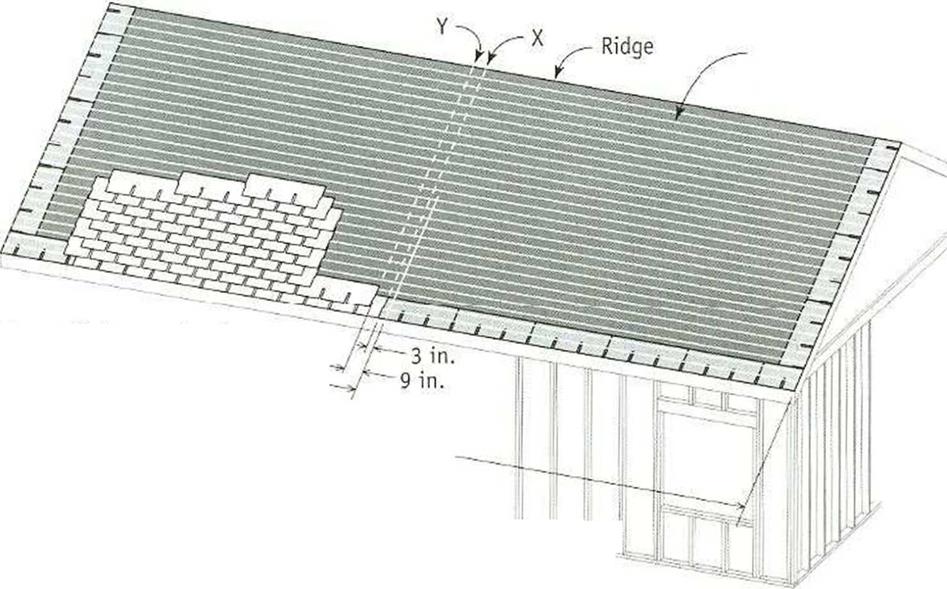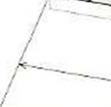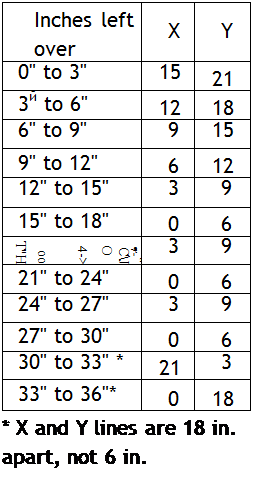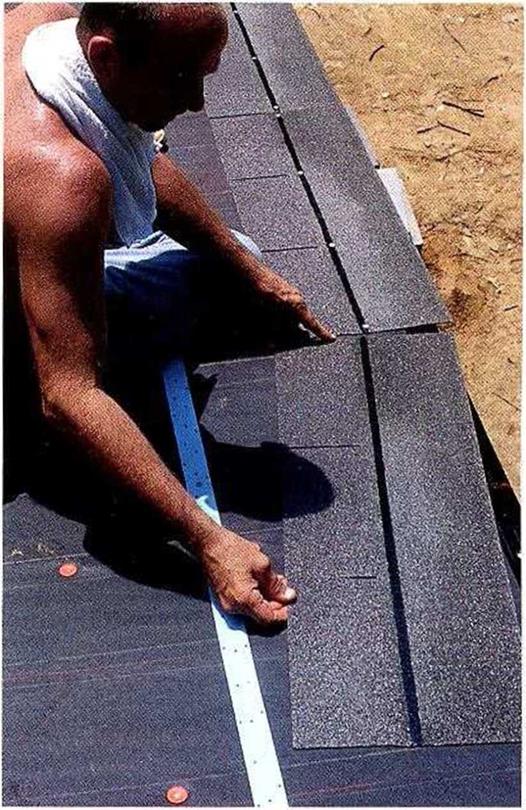The Right Vertical Layout for Roof Shingles
TO OBTAIN THE RIGHT LAYOUT,
try this two-step method:
1. Measure across the roof from out side edge to outside edge (parallel with the eave wall), including the planned overhang distance for the shingles. For example, let’s assume that the shingles will overhang the drip edge by / in. Measure in yards
(since the length of a standard shingle is 36 in.), plus remaining inches.
2. Measure in from the left edge by a round number of yards (sav, 5 yards) and mark that distance on the roof. Then refer to the chart below to ensure that all the shingles at the edges of the roof will beat least 13 in. wide (a full tab, plus 3 in.).
Example: Lets say the total distance across the roof, from gable end to gable end, is 10 yd. and 13 in. (including the ‘/-in. overhang at both ends). When you check the charts recommendations for a roof with a 13-in. remainder (12 in. to 15 in. is the range), you’ll see that the recommended offsets are 3 in. and 9 in.
From the reference mark at 3 yd., make marks 3 in. to the








 left and 9 in. to the left of the reference mark. You now have an offset of 6 in., or half the width of a shingle tab, between courses. Staggering the courses like this—so that the breaks between the tabs don’t stack up on top of each other— prevents water from seeping beneath the shingles. Make the З-in. and 9-in. offset marks at the bottom of the roof, near the eave, and at the top, near the ridge. Snap chalklines between the marks to establish your vertical start lines.
left and 9 in. to the left of the reference mark. You now have an offset of 6 in., or half the width of a shingle tab, between courses. Staggering the courses like this—so that the breaks between the tabs don’t stack up on top of each other— prevents water from seeping beneath the shingles. Make the З-in. and 9-in. offset marks at the bottom of the roof, near the eave, and at the top, near the ridge. Snap chalklines between the marks to establish your vertical start lines.
Follow the vertical and horizontal lines and start nailing down shingles. Make the starter course two layers thick to provide extra protection at the roof’s edge.
STARTER COURSE, BOTTOM LAYER. All shingles (including wood) are meant to overlap» providing a double layer of protection from the elements. That’s why the starter course must be two layers thick. For the first layer, lay the shingles the “wrong” way so that the three tabs lace up. The stone surface should also face up (see the photo below). Hold the long part of the shingle to the starter line and the right edge of the shingle to one of the vertical offset lines that you snapped near the center of the roof. With either a hammer or a pneumatic nailer, drive four л-in. large head roofing nails into each shingle just above the tar strip (see the illustration on p. 139). T he tar strip is near the center of each shingle and bonds one course to the next, keeping everything in place when the wind blows. Run these shingles up the gable ends, loo. Remember to use shorter nails around the perimeter of the roof if the house has open caves. Butt the starter shingles tightly to each other.


 If vou live in a verv vvindv area, you can make the starter course even more secure with I just a little extra effort. For the bottom layer of I the starter course, cut off the three tabs on each shingle just below the tar strip. Snap a line the width of this narrower shingle around I the roof’s perimeter. When you install the narrow shingles, the tar strip will be very close to the edge of the roof. Nail the narrow shingles. in. or so from the roof’s edge with their tar strips down. When the sun heats up the tar strip, this layer of shingles will be sealed to the roofing felt below.
If vou live in a verv vvindv area, you can make the starter course even more secure with I just a little extra effort. For the bottom layer of I the starter course, cut off the three tabs on each shingle just below the tar strip. Snap a line the width of this narrower shingle around I the roof’s perimeter. When you install the narrow shingles, the tar strip will be very close to the edge of the roof. Nail the narrow shingles. in. or so from the roof’s edge with their tar strips down. When the sun heats up the tar strip, this layer of shingles will be sealed to the roofing felt below.






Leave a reply